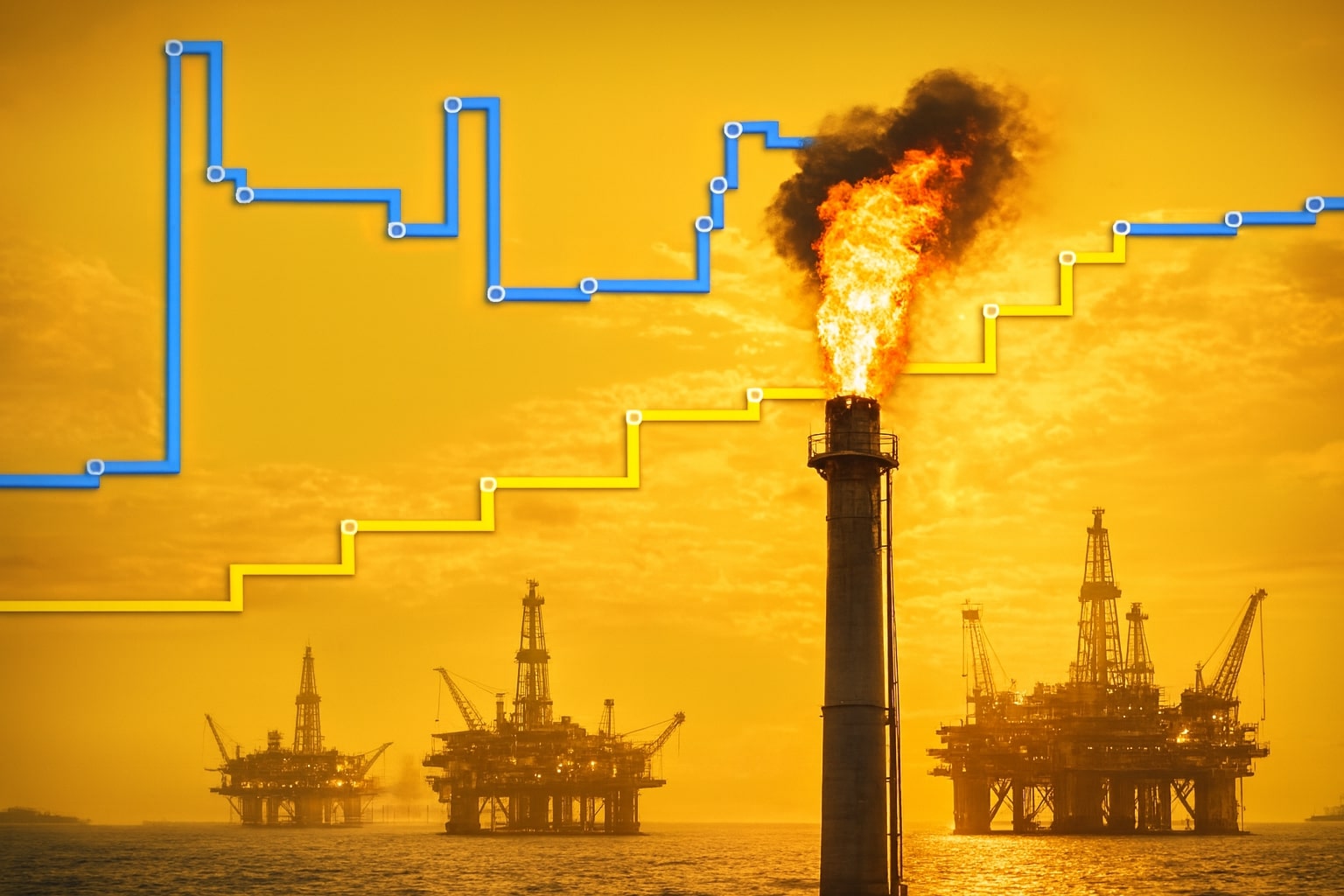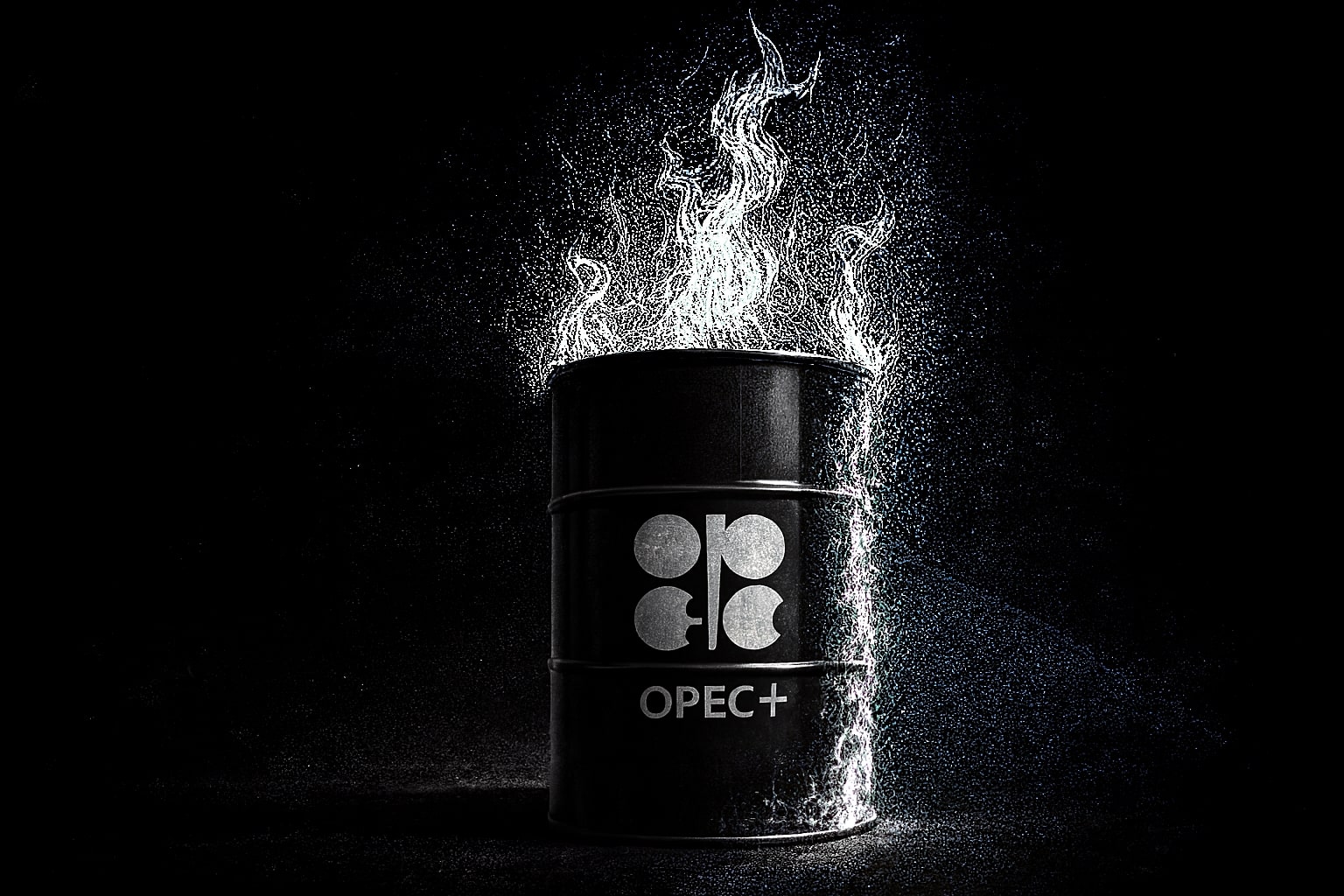
Natural Gas Price (NG=F) Retreats to $4.27 as Mild Weather and Record Output Cap Rally
With production surging to 110 bcf/day and U.S. gas demand down 2.7% YoY, resistance at $4.45 keeps prices range-bound ahead of winter forecasts | That's TradingNEWS
Natural Gas (NG=F) Struggles at $4.42 Resistance as Warm Weather and Rising Output Pressure Prices
Natural gas futures retreated to $4.27 after failing to sustain momentum above the $4.42 high, forming what now appears to be a four-day top that signals exhaustion in the recent rally. Sellers regained control as traders digested forecasts calling for mild U.S. temperatures through November 21, curbing heating demand just as production trends upward. The December Nymex contract closed 0.96% lower, confirming bearish sentiment into the next trading week.
Warm Weather Outlook Caps Heating Demand and Triggers Profit-Taking
Weather forecaster G2 Analytics reported that temperatures across the western and central United States will remain above seasonal norms through mid-November, with limited cold intrusions expected before the Thanksgiving period. This outlook sharply reduced near-term heating demand projections, weighing on NG=F futures. The U.S. Lower-48 gas demand dropped to 77.0 bcf/day, down 2.7% year-over-year, while production rose 8.1% to 110.0 bcf/day, creating a clear supply-demand imbalance. The immediate consequence was a rapid retreat from intraday highs, as traders unwound bullish positions anticipating stronger winter consumption that has yet to materialize.
Technical Resistance Forms Between $4.41 and $4.45
A critical Fibonacci resistance cluster continues to define the upper boundary of the current trading structure. The 78.6% retracement level at $4.41 and the 161.8% ABCD projection at $4.45 align tightly, forming a dominant cap on upside attempts. This resistance zone has rejected price advances twice this week, confirming the integrity of overhead supply. The extended upper channel line intersects this region, reinforcing the likelihood that $4.41–$4.45 remains the short-term ceiling for Natural Gas (NG=F) unless a strong catalyst emerges.
Four-Day Topping Pattern Hints at Consolidation Ahead
Natural gas now trades within a narrow four-day range defined by a $4.27 low and $4.42 high, suggesting an inside-day setup that could resolve into a corrective pullback. A break below $4.27 would mark the first technical confirmation of weakness, with next supports at $4.18, $4.01, and $3.94. The pattern reflects waning bullish momentum after consecutive tests of resistance, a structure that often precedes consolidation or a mild retracement phase before another potential leg higher.
Inventory Data Remains Neutral But Confirms Ample Supply
The latest EIA storage report showed inventories increasing +33 bcf for the week ending October 31 — exactly in line with market consensus and below the five-year average of +42 bcf. Current gas inventories stand 4.3% above the five-year seasonal average and 0.4% higher year-over-year, reinforcing the market’s comfort with storage levels heading into winter. Meanwhile, European gas reserves are 83% full, lower than the historical 92% benchmark, but sufficient to temper fears of an immediate supply crisis. This stable storage outlook is preventing speculative spikes in NG=F, despite upcoming colder months.
Production Surge and Rig Count Growth Add Bearish Pressure
The latest Baker Hughes data highlighted a sustained ramp-up in U.S. drilling activity. The active gas rig count rose by three to 128, marking a 2.25-year high. Over the past twelve months, rigs climbed from a 4.5-year low of 94, reflecting an industry-wide commitment to capitalize on stable margins and global LNG demand. The EIA’s October 7 forecast further raised its 2025 U.S. production estimate to 107.14 bcf/day, up 0.5% from September. The sheer scale of this output—already near record highs—has contributed to a structural oversupply in the domestic market. Unless exports expand sharply or winter temperatures turn colder than expected, supply will continue to outpace demand through Q4 2025.
Export Flows and LNG Terminals Offer Limited Relief
Estimated LNG net flows to export terminals stood at 17.3 bcf/day, a 0.8% week-over-week decline, suggesting slightly weaker global shipment volumes. While demand from Europe and Asia remains stable, warmer temperatures across both continents are muting incremental cargo demand. U.S. export terminals, including Freeport, Sabine Pass, and Calcasieu Pass, are operating at strong capacity utilization, yet overall flow stagnation highlights that external demand is not strong enough to offset surging domestic supply.
Supportive Electricity Demand Offers Partial Cushion
Electric utility data from the Edison Electric Institute showed U.S. lower-48 power generation rising 0.05% year-over-year to 73,730 GWh for the week ending November 1, while 12-month output reached 4.28 million GWh, up 2.89% year-over-year. This steady power consumption indicates ongoing industrial resilience and continued baseline natural gas use for electricity generation, which now accounts for over 39% of total U.S. power supply. However, this moderate growth remains insufficient to absorb the full excess in production, leaving natural gas futures under pressure despite steady base-load demand.
Short-Term Outlook: Resistance Holds, Support Tested
The 10-day moving average near $4.01 is now the first key dynamic support. Below that, the 38.2% Fibonacci retracement at $3.94 converges with the previously broken channel top, a region likely to attract bargain buying. A decisive breakdown below $3.94 would shift control to sellers and open potential downside toward $3.70, while a clean move above $4.45 could revive momentum toward $4.70–$4.90. Volume behavior indicates that traders are scaling back leveraged positions, awaiting either a cold-weather catalyst or renewed LNG strength before committing to new longs.
Macro Drivers and Pipeline Sector Context
Parallel to spot and futures movements, infrastructure assets tied to gas transportation such as the Tortoise North American Pipeline Fund ETF (NYSEARCA:TPYP) reflect broader midstream trends. TPYP trades at $34.97, up 1.08%, with holdings in Kinder Morgan (KMI), Williams Companies (WMB), and Cheniere Energy (LNG) showing resilience despite short-term commodity weakness. The ETF’s performance underscores how rising pipeline throughput and LNG exports create structural value even as spot gas prices fluctuate. This sector stability indirectly supports confidence in long-term NG=F price floors around $3.80–$4.00, a zone consistent with historical breakevens for producers.
Read More
-
SMH ETF: NASDAQ:SMH Hovering at $350 With AI, NVDA and CHIPS Act Fueling the Next Move
16.12.2025 · TradingNEWS ArchiveStocks
-
XRP ETFs XRPI and XRPR: Can $1B Inflows Lift XRP-USD From $1.93 Back Toward $3.66?
16.12.2025 · TradingNEWS ArchiveCrypto
-
Natural Gas Price Forecast: NG=F Falls to $3.80–$3.94 as Warm Winter Kills $5.50 Spike
16.12.2025 · TradingNEWS ArchiveCommodities
-
USD/JPY Price Forecast - USDJPY=X Slides, BoJ 0.50% Hike, Fed Cut and NFP Set the Next Big Move
16.12.2025 · TradingNEWS ArchiveForex
Market Sentiment and Forward Curve Positioning
Futures data show the December–February 2026 strip pricing between $4.20 and $4.70, signaling mild backwardation but not enough to indicate panic-driven accumulation. Traders remain cautious, balancing expectations of seasonal tightening against evidence of high storage and resilient production. The Fear & Greed Index for commodities remains near 38/100, indicating mild risk aversion but not capitulation. Technical momentum oscillators reflect this uncertainty: RSI sits at 46, and MACD momentum has flattened near zero, consistent with an extended consolidation pattern.
Verdict — Natural Gas (NG=F) Is a Short-Term Hold With Bearish Bias Pending Cold Shift
At $4.27, natural gas faces a pivotal test. The combination of record U.S. production (110 bcf/day), robust rig activity, and above-average storage suggests limited upside unless weather-driven demand surprises. A break above $4.45 could extend gains toward $4.90, but absent that, prices are likely to consolidate or soften back toward $4.00 in the short term. Long-term structural support from LNG expansion and midstream investment justifies maintaining exposure, yet momentum currently favors sellers.
Rating: Hold (Bearish Bias)
12-Month Range: $3.70–$4.90
Key Catalyst: Weather Reversal and Winter Heating Demand Shift
Support Zone: $3.94–$4.01
Resistance Zone: $4.41–$4.45
Current Price: $4.27



















